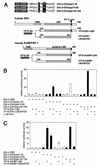LXXLL-related motifs in Dax-1 have target specificity for the orphan nuclear receptors Ad4BP/SF-1 and LRH-1
- PMID: 12482977
- PMCID: PMC140654
- DOI: 10.1128/MCB.23.1.238-249.2003
LXXLL-related motifs in Dax-1 have target specificity for the orphan nuclear receptors Ad4BP/SF-1 and LRH-1
Abstract
The orphan receptor Ad4BP/SF-1 (NR5A1) is a constitutive activator, and its activity is repressed by another orphan receptor, Dax-1 (NR0B1). In the present study, we investigated the molecular mechanisms underlying this repression by Dax-1. Yeast two-hybrid and transient-transfection assays confirmed the necessity of three LXXLL-related motifs in Dax-1 for interaction with and repression of Ad4BP/SF-1. In vitro pull-down experiments confirmed that Dax-1 interacts with Ad4BP/SF-1 and also with LRH-1 (NR5A2). The target specificity of the LXXLL-related motifs was indicated by the observations that Ad4BP/SF-1, ERalpha (NR3A1), LRH-1, ERR2 (NR3B2), and fly FTZ-F1 (NR5A3) interacted through their ligand binding domains with all the LXXLL-related motifs in Dax-1 whereas HNF4 (NR2A1) and RORalpha (NR1F1) did not. Transcriptional activities of the receptors whose DNA binding domains (DBDs) were replaced by the GAL4 DBD were repressed by Dax-1 to various levels, which correlated with the strength of interaction. Amino acid substitutions revealed that Ad4BP/SF-1 and LRH-1 preferentially interact with L(+1)XXLL-related motifs containing serine, tyrosine, serine, and threonine at positions -2, +2, +3, and +6, respectively. Taken together, our results indicate that the specificities of LXXLL-related motifs in Dax-1 based on their amino acid sequences play an important role in regulation of orphan receptors.
Figures







Similar articles
-
Role of the LXXLL-motif and activation function 2 domain in subcellular localization of Dax-1 (dosage-sensitive sex reversal-adrenal hypoplasia congenita critical region on the X chromosome, gene 1).Mol Endocrinol. 2003 Jun;17(6):994-1004. doi: 10.1210/me.2002-0360. Epub 2003 Feb 27. Mol Endocrinol. 2003. PMID: 12610109
-
Dax-1 (dosage-sensitive sex reversal-adrenal hypoplasia congenita critical region on the X chromosome, gene 1) gene transcription is regulated by wnt4 in the female developing gonad.Mol Endocrinol. 2003 Apr;17(4):507-19. doi: 10.1210/me.2002-0362. Epub 2003 Jan 23. Mol Endocrinol. 2003. PMID: 12554773
-
LXXLL motifs in Dax-1 have target specificity for the orphan nuclear receptors Ad4BP/SF-1 and LRH-1.Endocr Res. 2002 Nov;28(4):537. doi: 10.1081/erc-120016835. Endocr Res. 2002. PMID: 12530660 No abstract available.
-
Phenotypic spectrum of mutations in DAX-1 and SF-1.Mol Cell Endocrinol. 2001 Dec 20;185(1-2):17-25. doi: 10.1016/s0303-7207(01)00619-0. Mol Cell Endocrinol. 2001. PMID: 11738790 Review.
-
DAX-1, an 'antitestis' gene.Cell Mol Life Sci. 1999 Jun;55(6-7):857-63. doi: 10.1007/pl00013201. Cell Mol Life Sci. 1999. PMID: 10412368 Free PMC article. Review.
Cited by
-
PPAR-gamma coactivator-1alpha regulates progesterone production in ovarian granulosa cells with SF-1 and LRH-1.Mol Endocrinol. 2010 Mar;24(3):485-96. doi: 10.1210/me.2009-0352. Epub 2010 Feb 4. Mol Endocrinol. 2010. PMID: 20133449 Free PMC article.
-
Exportin 4 interacts with Sox9 through the HMG Box and inhibits the DNA binding of Sox9.PLoS One. 2011;6(10):e25694. doi: 10.1371/journal.pone.0025694. Epub 2011 Oct 3. PLoS One. 2011. PMID: 21991335 Free PMC article.
-
Differentiation of mesenchymal stem cells into gonad and adrenal steroidogenic cells.World J Stem Cells. 2014 Apr 26;6(2):203-12. doi: 10.4252/wjsc.v6.i2.203. World J Stem Cells. 2014. PMID: 24772247 Free PMC article. Review.
-
LXXLL motifs and AF-2 domain mediate SHP (NR0B2) homodimerization and DAX1 (NR0B1)-DAX1A heterodimerization.Mol Genet Metab. 2007 Sep-Oct;92(1-2):151-9. doi: 10.1016/j.ymgme.2007.06.009. Epub 2007 Aug 7. Mol Genet Metab. 2007. PMID: 17686645 Free PMC article.
-
Nonsense variant of NR0B1 causes hormone disorders associated with congenital adrenal hyperplasia.Sci Rep. 2021 Aug 9;11(1):16066. doi: 10.1038/s41598-021-95642-y. Sci Rep. 2021. PMID: 34373561 Free PMC article.
References
-
- Altincicek, B., S. P. Tenbaum, U. Dressel, D. Thormeyer, R. Renkawitz, and A. Baniahmad. 2000. Interaction of the corepressor Alien with DAX-1 is abrogated by mutations of DAX-1 involved in adrenal hypoplasia congenita. J. Biol. Chem. 275:7662-7667. - PubMed
-
- Boerboom, D., N. Pilon, R. Behdjani, D. W. Silversides, and J. Sirois. 2000. Expression and regulation of transcripts encoding two members of the NR5A nuclear receptor subfamily of orphan nuclear receptors, steroidogenic factor-1 and NR5A2, in equine ovarian cells during the ovulatory process. Endocrinology 141:4647-4656. - PubMed
-
- Bourguet, W., M. Ruff, P. Chambon, H. Gronemeyer, and D. Moras. 1995. Crystal structure of the ligand-binding domain of the human nuclear receptor RXRα. Nature 375:377-382. - PubMed
-
- Brzozowski, A. M., A. C. Pike, Z. Dauter, R. E. Hubbard, T. Bonn, O. Engstrom, L. Ohman, G. L. Greene, J. A. Gustafsson, and M. Carlquist. 1997. Molecular basis of agonism and antagonism in the oestrogen receptor. Nature 389:753-758. - PubMed
-
- Chang, C., J. D. Norris, H. Gron, L. A. Paige, P. T. Hamilton, D. J. Kenan, D. Fowlkes, and D. P. McDonnell. 1999. Dissection of the LXXLL nuclear receptor-coactivator interaction motif using combinatorial peptide libraries: discovery of peptide antagonists of estrogen receptors α and β. Mol. Cell. Biol. 19:8226-8239. - PMC - PubMed
Publication types
MeSH terms
Substances
LinkOut - more resources
Full Text Sources
Molecular Biology Databases
Miscellaneous
